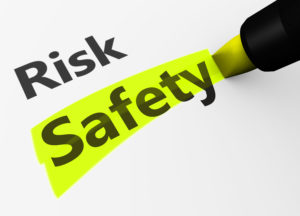Safety and health must be a top priority in all work settings. According to U.S. Bureau of Labor Statistics, more than 3.6 million serious injuries or illnesses and over 5,000 deaths occur on the job each year. Furthermore, the 2020 Liberty Mutual Workplace Safety Index states, “Disabling workplace injuries cost businesses more than $59 billion per year.” A lack of proper safety measures puts your employees and your organization at risk.
The Occupational Safety and Health Administration (OSHA) is currently running the Safe + Sound campaign (see more here) to encourage all workplaces to implement a safety and health program that fits their specific needs. According to the campaign’s overview, some of the benefits of a safety and health program include preventing workplace illness and injury, reducing injury related costs, improving legal compliance, and increasing productivity. An effective safety and health program requires a systematic approach to addressing safety concerns, training, ongoing communication, and buy in at all levels.
Systematic Approach
The Safe + Sound campaign emphasizes the importance of taking proactive measures to prevent workplace illness and injury. Instead of only addressing problems once someone is hurt, everyone should carry out routine procedures to identify and resolve safety concerns. Depending on your industry, procedures may include daily equipment inspections, surveying of the job site for hazards, and/or routine employee evaluations. In addition, all organizations should plan for emergencies and nonroutine events such as inclement weather, fires, power outages, and workplace violence. Policies and procedures for incident reporting should be defined in advanced to ensure that all work-related injuries and illness are properly documented and investigated. Finally, the program itself should be routinely evaluated for its effectiveness.
Ongoing Training and Communication
Having safety and health policies in place does not equate to actively promoting safety in the workplace. Making all new hires read and sign an acknowledgement of these safety and health policies also does not equate to actively promoting safety in the workplace. Promoting safety in the workplace requires routine training and open communication among all members of your organization. The Concentra article, “10 Simple Steps to Improve Workplace Safety,” by Michelle Hopkins puts training at the top its list. It states, “Comprehensive training is a must for preventing workplace injury. Make sure that all of your employees have access to – and complete – all safety training for their positions.” If you have ever been given an online training module to complete, you would understand the temptation to daydream, check your phone, online shop, or do just about anything besides pay attention to the training. Measures must be in place to ensure that everyone completes and pays attention to safety training. Additionally, safety training should not be a one-and-done occurrence. Routine training and follow up keeps safety at the top of everyone’s mind and conveys that it is something that your workplace truly values.
As stated above, promoting safety requires communication between employees and management at all levels. Everyone must know how to report incidents, concerns, and suggestions and should feel comfortable doing so. OSHA’s Safety + Health Programs Overview states, “To maximize participation, [in a safety and health program] however, workers must feel free of any fear of retaliation or discrimination (e.g., for reporting an injury or hazardous conditions).” Hotline and case management systems such as Red Flag Reporting allow employees to easily and anonymously share their concerns knowing that their reports will go to the right person.
Buy In at All Levels
Everyone should be a stakeholder when it comes to promoting and maintaining a safe workplace. OSHA’s Safety + Health Programs Overview defines roles for both management and workers. Those at the top must lead by example to demonstrate a commitment to the program. They must always practice safe behaviors while working and must consider safety when planning and decision making. Management should also reward employees who demonstrate safe work practices. Workers should be involved in the creation of the safety and health program and all policies and procedures. Experienced workers often know more about safe practices and potential hazards than management. OSHA recommends that workers participate by developing and evaluating the program, defining safe work practices, training coworkers and new hires, analyzing hazards, and reporting incidents.
In summary, it takes commitment and collaboration between all members to promote safety in the workplace. When management leads by example and prioritizes safety in planning and decision making, employees know that their health and wellbeing is valued. In return, employees feel empowered to make safe choices and to express concerns and suggestions for improvement to management. An Effective safety and health programs protect organizations and everyone involved.
Not a client of Red Flag Reporting’s hotline services? As a leading hotline provider, contact us to learn how our hotline services can protect your organization and your people.
[More important considerations on employee safety – see our article here.]
